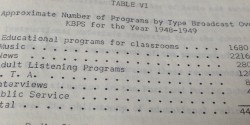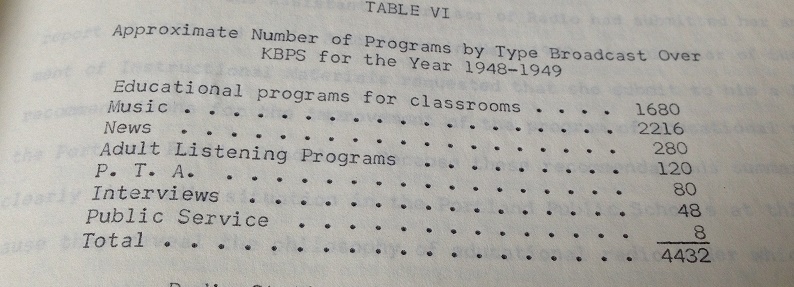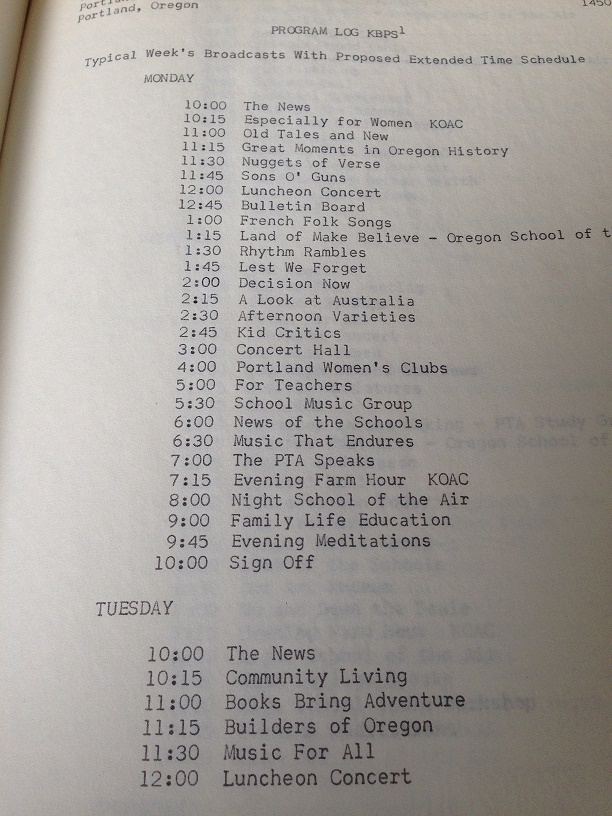A few months back, in honor of High School Radio Day, I wrote about possibly the oldest high school radio station in the United States, KBPS-AM in Portland, Oregon. In the course of researching the Benson Polytechnic High School radio station, I learned that one of its General Managers, Patricia Green Swenson (who led the station from around 1947 until 1994), wrote a doctoral thesis in 1958 about the history of the station.
I tracked down the thesis, Radio in the Public Schools of Portland, Oregon: The Historical Development of Educational Broadcasting in the Public Schools of Portland, Oregon, and of the Schools’ Radio Station, KBPS, and found some fascinating tidbits about the early history of high school/educational radio. The dissertation specifically looks at the period of 1923 to 1950 and it offers an incredible glimpse into the early days of radio.
She explains that “broadcasting to schools began as early as 1923. In 1923 Haaren High School in New York City broadcast programs on accounting, and in the following year schools in Oakland, California, were receiving geography, history, and English lessons broadcast to their classrooms.”
As Swenson’s degree was from New York University’s School of Education, much of the dissertation focuses on the educational uses of high school radio. In her introduction, Swenson writes that the project, “…examines a program of educational radio in a public school system in the light of established principles relating to radio as a source of enriched learning experiences for schools.” Radio programs with specific educational goals were broadcast into elementary school through high school classrooms over KBPS during the period of the study.
For me, however, the back story of how the station came to be is perhaps one of the more interesting tales.
High School Radio as an Antidote to Juvenile Delinquency?
Located at a technical/vocational high school, KBPS launched in 1923 and its beginnings were described to Swenson by the station’s first technical advisor, W.D. Allingham. According to Allingham,
In the year 1922-1923, the Benson Polytechnic School had an enrollment of around 350 to 400 students. There occurred just at this time considerable rowdyism in the city, perpetuated by some of the Benson students. Several Benson faculty members led by Principal Cleveland were seeking a means to ‘whitewash this surge of juvenile delinquency,’ to give students an outlet for their interests, to sway public opinion more in favor of Benson, and to increase enrollment of the school.”
The AM station KYG was offered to the school and it was decided that the student body would purchase it. There was already an active Benson Radio Club, which helped to install the new radio station on campus. KFIF were its initial call letters (up until 1930), with the station officially debuting on May 9, 1923.
KFIF’s Early Days of Live Programming
According to Swenson, “During the first eight to ten years of operation all the programs were live programs. Records were too poor to be used in those early days and the station continually tried to bring in the ‘artists’ of the community to its listeners.” Numerous musicians came to perform live over KFIF during its first year and the addition of a grand piano to the station enhanced its appeal to the “many accomplished pianists, singers, and instrumentalists….” as well as performers from “visiting opera and touring musical companies,” according to Swenson.
In addition to music, KFIF also presented lectures and programming from a wide range of experts and local organizations, aired sports broadcasts and school assemblies, as well as “portions of Benson class plays, pep rallies…” and more, writes Swenson.
Through it all, the station was also training students in radio broadcasting, although, “Adult, rather than student talent, had been used for the majority of early programs,” according to Swenson.
Educational Programming in the Evening Hours and In the Classroom
Between 1928 and 1938, KFIF/KBPS worked increasingly to create educational programs for both in-school use and for after-school time. After school programs included concerts, sports, classes, and local government broadcasts. Additionally, local commercial radio stations also created educational content, including the weekly “Great Moments in History/Talking Text-Books” program, which launched over commercial radio station KEX in 1931. Another series that followed in 1934 is described in a story in the Oregonian, as quoted by Swenson:
Books and pencils will be shunted aside by Portland public school children every Wednesday morning while radio waves carry dramatizations of important news events from KEX, The Oregonian, directly into the classrooms…Adoption of radio as an effective method of instruction is a part of the progressive policy of the Portland Public School administration.”
The problem, though, was that schools didn’t necessarily have enough radios on which students could listen to these educational programs. Proponents worked to rally schools and PTAs in order to purchase enough radio sets so that programming could be heard.
It’s interesting to read about radio in the schools as “progressive” education and it reminds me of more recent attempts to get more laptops, iPads, and other forms of technology into schools. At the same time, as I read about commercial radio stations in the 1930s producing programs to air in public schools, I’m also reminded of organizations like Channel One, which brought school-specific television programming into schools beginning in 1989. Ever since its national launch in 1990, Channel One stirred up controversy, as it provided free equipment and programming to schools who aired the shows along with accompanying commercials.
Although educational programs from commercial radio station were a staple at KBPS, there’s no mention of whether or not commercials were actually aired in the classroom.
More Students on the Air Starting in the Late 1930s
Starting in 1939, following the appointment of a new KBPS advisor, Hazel Kenyon, the station was “opened for the entire school system” with students from every school in the district eligible to get on the air. This led to a “daily all-city school and community group news series” called “What’s Going On?”, live drama from local high schools, an increase in the number of student announcers, as well as “the establishment of a new, weekly, after-school course for these students in radio announcing techniques and board operation,” according to Swenson.
During Kenyon’s tenure, a dizzying number of interesting projects were established, including the addition of radio writing and production classes at three high schools, the launch of an elementary-school created radio interview series, and a range of high school radio series (including a singers club, Spanish lessons, news, and “dramatized Oregon history programs”).
Kenyon left KBPS in 1941 to become the Director of Education for a new Seattle station, KIRO.
Portland Schools Rejects Offer to Buy KBPS + High Interest in Radio in 1940s
In 1945, the school district received two offers to purchase KBPS and both were rejected. For KBPS this was affirmation of “the increasing value put upon the station by the schools’ Board of Directors and administrative leaders,” according to Swenson. By the late 1940s, schools in Portland were deeply interested in participating over the air on KBPS. Swenson points out that more than 400 children and adults passed through the KBPS studios in a given week, which made scheduling studio time a logistical challenge.
Student Operation
Throughout the entire period of her study, students were in charge of technical operations of KBPS. Swenson writes, “Since 1923, KBPS has maintained (under a carefully planned, though minimum, of adult supervision) complete operation of its studio, transmitter, and remote broadcast facility controls by Benson Polytechnic High School students in order to give these Benson students who were technical radio majors actual on-the-air experiences in the operation of all phases of a real broadcast radio station.”
Additionally, students covered high school sports competitions, doing all of the play-by-play for several different sports, including football, basketball, and baseball.
At the conclusion of the study, Swenson does not reflect back on KBPS’ original noble goals of improving the school’s image in light of the scourge of juvenile delinquency, but the extensive radio program seems to speak for itself, as it grew into a highly regarded place for students to learn about and participate in radio.
Fast forward 65 years and in 2015, radio education continues at KBPS with a rigorous broadcast curriculum at Benson High School.





